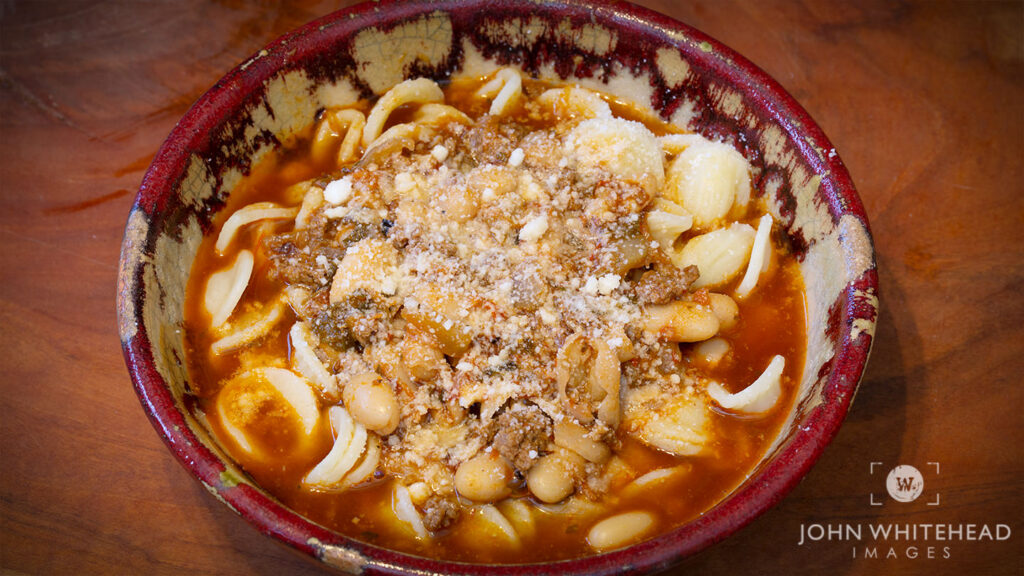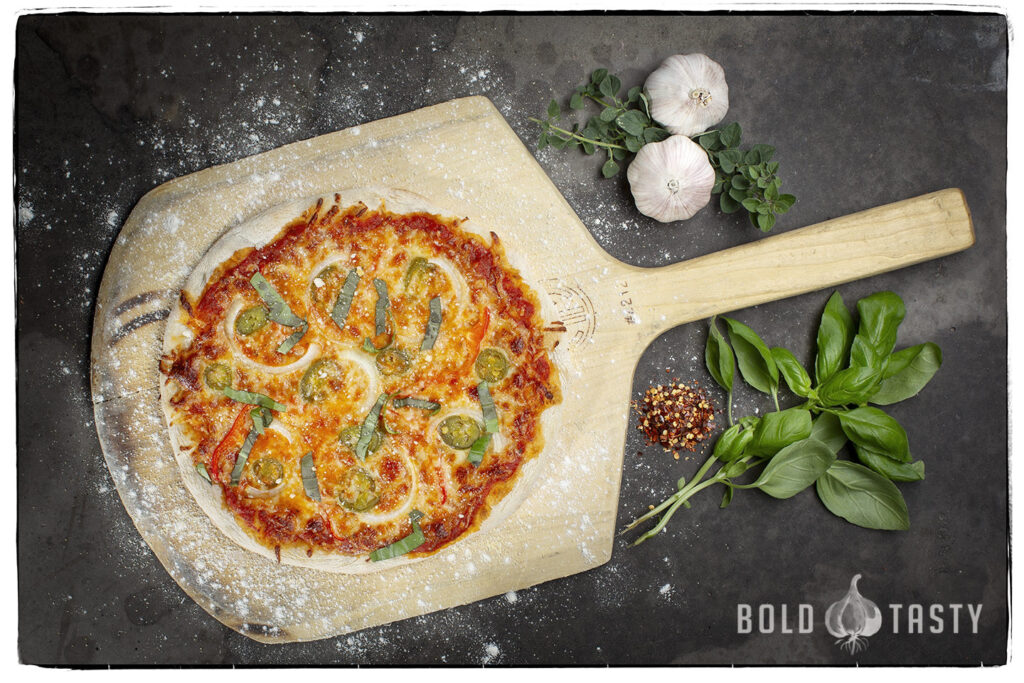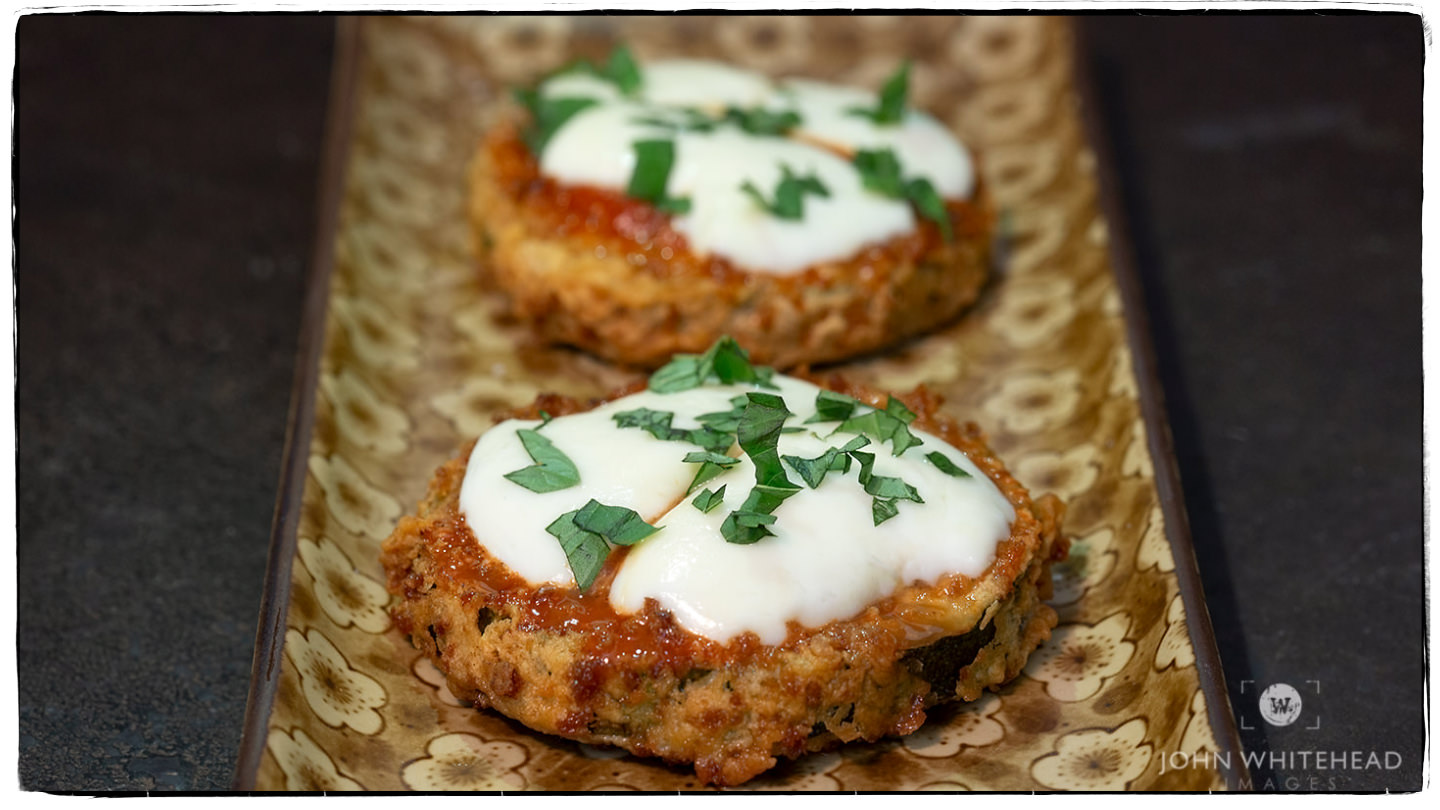
From Garden to Oven: How to Make Mouthwatering Zucchini Pizza
Summertime abundance finds its perfect match in the delectable offerings of zucchini. Whether in the form of zucchini pizza or crispy fried slices adorned with the delightful combination of tomato, mozzarella, and a drizzle of balsamic glaze, these culinary delights are a quintessential choice for the season’s culinary escapades.
That Extra Large Zucchini
Every year, without fail, I find myself sharing an ample harvest of zucchini with my neighbors, a testament to the prolific nature of this versatile vegetable. The zucchini plants flourish, yielding a bounty that seems almost endless, often surpassing the capacity to consume them within a mere month. Amongst the lush greenery, occasionally a few zucchinis elude my grasp, growing a tad larger than intended. Yet, these sizable specimens turn out to be perfect candidates for a scrumptious frying endeavor.
Frying Zucchini Pizza
Achieving culinary excellence in frying zucchini pizza hinges on mastering the art of thickness. Strike the right balance, and you’ll enjoy golden-brown slices that hold their shape—neither too thin to crumble nor too thick to overwhelm the palate. Embrace this culinary adventure with two easy recipes you can prepare in under half an hour.. Give this zucchini pizza a try! If you like pizza you can give this thin and crispy pizza try.
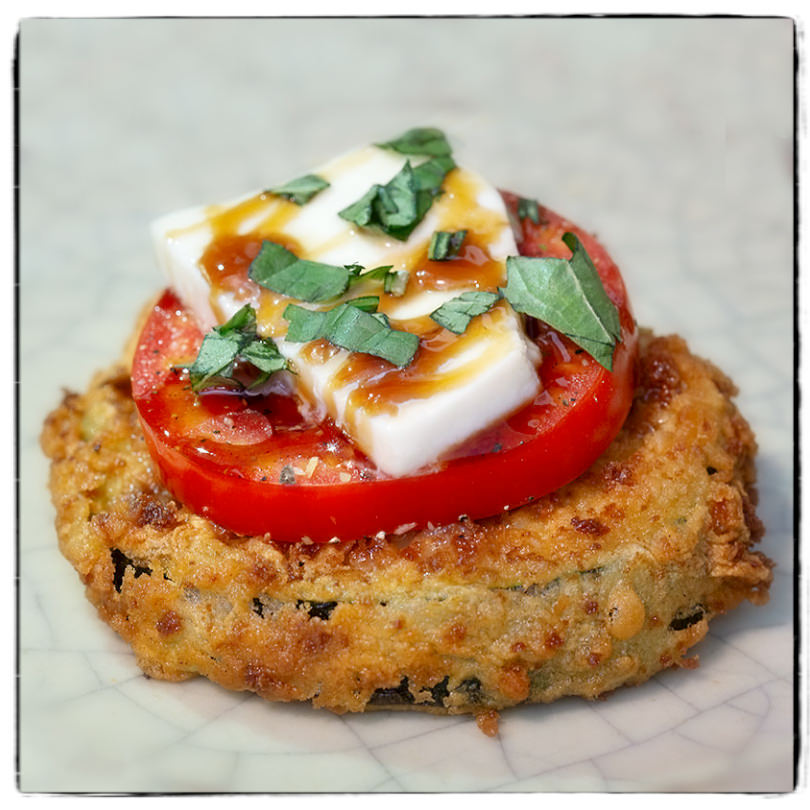
Fried Zucchini with tomato, mozzarella, and balsamic glaze
To assemble, place fried zucchini on a plate. Add sliced tomato, fresh mozzarella, and balsamic glaze. Garnish with fresh basil if desired. I do not melt the cheese, but you could. I would do this without the tomato so the zucchini does not become soggy.
How to Bread Zucchini for Zucchini Pizza
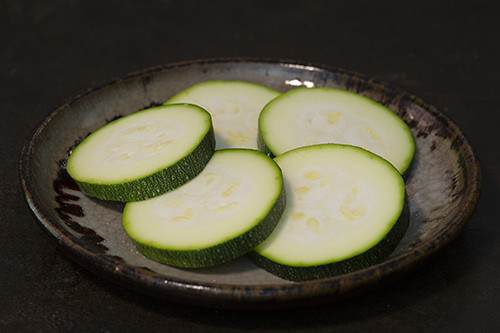
Slice Zucchini
Slice zucchini 3/16 to 1/4″ inch” round and salt.
Dust Zucchini
Dust fresh zucchini with all-purpose flour.
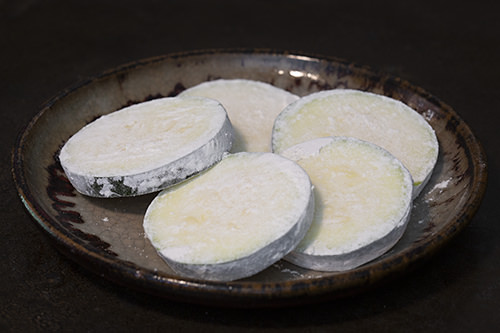
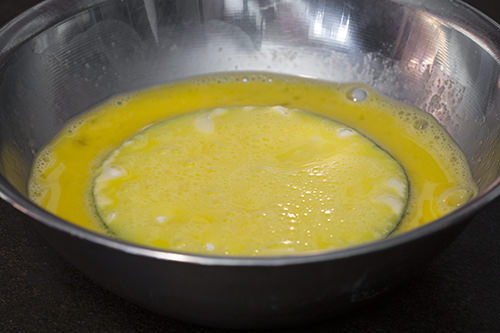
Egg Wash
Add floured zucchini into egg wash.
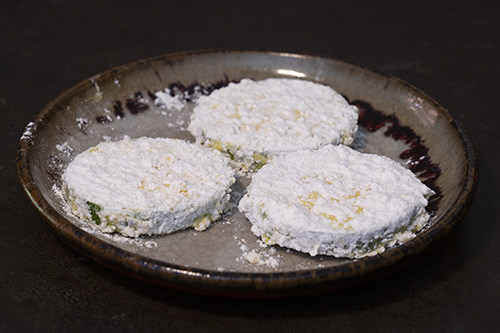
Bread Zucchini
Add egg washed zucchini into flour and Panko bread crumbs.
Fry Zucchini
Fry breaded zucchini in 1/4 inch of oil at 350 degrees on both sides.
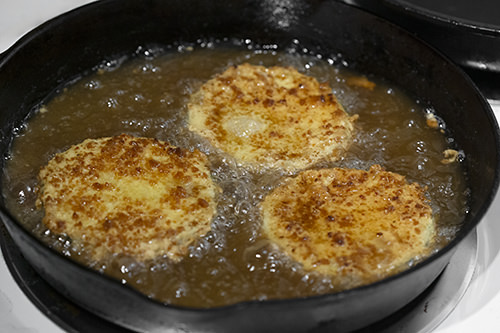
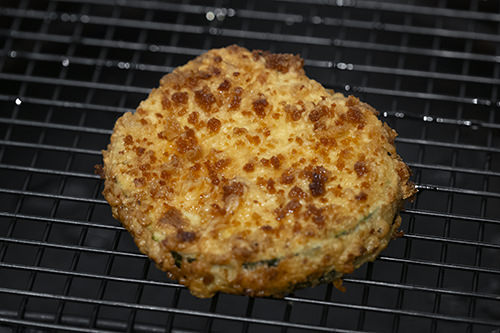
Egg Wash
Let your fried zucchini drain and cool on a wire rack.
The History of Zucchini
The history of zucchini traces back to ancient times and involves a journey across continents. Here’s a brief overview of its origins and evolution:
- Origin in the Americas: Zucchini, scientifically known as Cucurbita pepo, is believed to have originated in the Americas, particularly in the region that is now Mexico and Central America. It is a member of the squash family and was cultivated by indigenous peoples long before the arrival of Europeans.
- Introduction to Europe: After Christopher Columbus’s voyages to the Americas, zucchini, along with other indigenous crops, was brought back to Europe. However, initially, it was grown more for its decorative and ornamental purposes rather than as a food source.
- Cultivation and Culinary Use: Over time, zucchini gained popularity as a food crop in European cuisines. Its mild flavor and versatility made it a favorable ingredient. Italians are often credited with embracing zucchini as a culinary delight and incorporating it into their dishes. The word “zucchini” itself is derived from the Italian word “zucchino,” meaning a small squash.
- Spread and Varieties: As trade and exploration continued, zucchini spread across Europe and beyond. Different regions developed their own varieties and culinary traditions centered around zucchini. It is worth noting that while the term “zucchini” is commonly used in North America and some parts of Europe, in other places, it is referred to as “courgette.”
- Introduction to North America: Zucchini was introduced to the United States in the early 20th century, but it didn’t gain widespread popularity until later decades. In the mid-20th century, particularly during the 1950s and 1960s, zucchini experienced a surge in popularity as home gardening and interest in fresh produce grew.
- Cultural Influence: Zucchini became a staple in various cuisines around the world, from Mediterranean dishes to Mexican cuisine. Its mild flavor allows it to be incorporated into a wide range of recipes, from soups and stews to bread and pastries.
- Modern Consumption: Zucchini is now a common ingredient in many households and is often celebrated during the summer months when it is in abundance. It is enjoyed in various forms, including sautéed, grilled, fried, baked, and even spiralized into “noodles” as a low-carb alternative to pasta.
Throughout its history, zucchini has evolved from a decorative curiosity to a beloved and versatile ingredient in kitchens worldwide, reflecting the interconnectedness of cultures and the exchange of culinary traditions.
Ingredient of the Day-Fresh Mozzarella
Mozzarella, the beloved Italian cheese, has a special place in kitchens worldwide. But among the various types of mozzarella available, fresh mozzarella stands out for its delicate texture, milky flavor, and artisanal quality. In this guide, we’ll explore what makes fresh mozzarella unique, how it’s made, and ways to enjoy it in your favorite dishes.
What is Fresh Mozzarella?
Fresh mozzarella is a soft, mild cheese that originated in Italy and is known for its high moisture content and gentle, creamy flavor. Unlike other varieties of mozzarella, which are drier and better suited for melting, fresh mozzarella is meant to be enjoyed on its own or added to dishes just before serving.
Fresh mozzarella is typically sold in balls or rounds, immersed in water or whey to preserve its freshness. It has a smooth, slightly elastic texture that makes it tender to the bite and delightful when paired with simple ingredients.
The Origins of Fresh Mozzarella
Mozzarella was traditionally made using water buffalo milk in Italy, especially in the Campania region. The high-fat content of buffalo milk gives the cheese a richer, creamier flavor, and this variety is still considered a delicacy today. However, due to limited availability of buffalo milk, most fresh mozzarella today is made from cow’s milk, which is more accessible and provides a similarly delicious, albeit lighter, taste.
How Fresh Mozzarella is Made
The process of making fresh mozzarella is known as pasta filata or “spun paste,” where curds are heated, kneaded, and stretched to create the cheese’s soft, stringy texture. Here’s a quick rundown of the steps:
- Curdling: First, milk is heated and treated with rennet to form curds.
- Heating and Stretching: The curds are cut and heated in hot water, then kneaded and stretched until smooth. This stretching aligns the proteins and gives mozzarella its characteristic stretchiness.
- Shaping and Soaking: The cheese is shaped into balls or rounds and then placed in a brine or whey solution, which keeps it fresh and enhances its mild flavor.
This technique is what gives fresh mozzarella its delicate, tender texture and unique taste.
What Makes Fresh Mozzarella Different?
Unlike low-moisture mozzarella, which is commonly found shredded for pizza, fresh mozzarella has a softer, more delicate quality and should be consumed within a few days for optimal flavor. While low-moisture mozzarella is aged longer and has a firmer texture, fresh mozzarella is typically ready to eat within hours of being made. This high moisture content makes fresh mozzarella creamy and juicy, especially when enjoyed at room temperature.
How to Use Fresh Mozzarella
Fresh mozzarella shines in recipes that allow its flavor to take center stage. Here are some popular ways to enjoy it:
- Caprese Salad: Fresh mozzarella is often served alongside juicy tomatoes, fresh basil, and a drizzle of olive oil and balsamic vinegar.
- Pizza Margherita: This classic Italian pizza features fresh mozzarella melted over a tomato base with basil leaves for a simple yet satisfying meal.
- Pasta and Flatbreads: Add slices of fresh mozzarella to pasta dishes, lasagna, or flatbreads just before serving to enjoy its creamy texture.
- Antipasto Platters: It pairs beautifully with cured meats, olives, and crusty bread as part of a charcuterie board.
Storing Fresh Mozzarella
Fresh mozzarella is best enjoyed within a day or two of purchase, as it’s highly perishable. If you’re buying mozzarella that’s packed in water, it’s important to keep it refrigerated in its liquid to maintain moisture. Avoid storing it for more than a few days, as the texture and flavor can quickly decline.
Fresh mozzarella is a true delicacy, offering a gentle creaminess that complements a variety of dishes. Whether it’s enjoyed on a simple salad, a pizza, or a charcuterie board, fresh mozzarella’s mild, milky flavor can elevate any meal. So next time you’re at the cheese counter, treat yourself to a round of fresh mozzarella, and savor the delicious simplicity of this Italian classic!
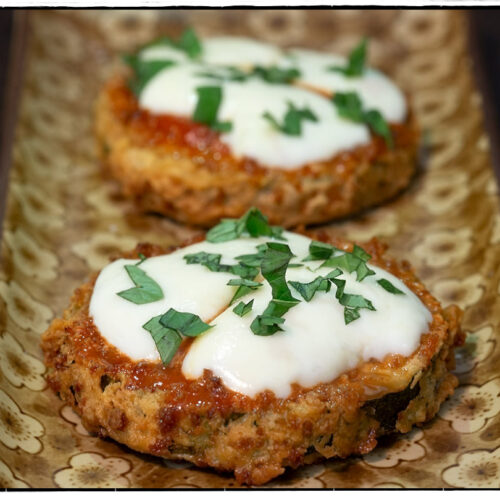
Zucchini Pizza and Zucchini with Fresh Mozzareall with Balsamic Glaze
Equipment
- 2 bowls
- 1 frying pan
- 1 baking sheet
Ingredients
Fried Zucchini
- 2 cups all-purpose flour whole wheat flour
- 1 cup panko bread crumbs whole wheat panko bread crumbs
- 3 large eggs
- 1 large zucchini
- 1 pinch salt
- oil to cover pan by 1/4 inch
Fried Zucchini Pizzas
- 1 can store bought or homemade pizza sauce
- 8 oz fresh mozzarella
- whole basil leaves
Fried Zucchini with Tomato, Mozzarealla, and Balsamic Glaze
- 8 oz fresh mozzarealla
- 1 whole fresh tomato like vine ripe
- 1 bottle balsamic glaze or reduce balsamic vinegar and sugar
- 10 leave fresh basil
Instructions
Fried Zucchini
- slice zucchini 3/16 to 1/4 inch into rounds and salt to taste. Larger zucchini's are better. This is for 12 zucchini1 large zucchini
- flour zucchini slices and place on plate or wax paper2 cups all-purpose flour
- beat eggs and coat floured zucchini for breading3 large eggs
- add Panko bread crumbs and mix with flour. Bread zucchini after coating with egg. Let breaded zucchini sit on wax paper or plate2 cups all-purpose flour, 1 cup panko bread crumbs, 1 pinch salt
- Fry zucchini in 350 degree oil until golden brown on both side. Drain on wire rack. If you oil starts to burn from flour add new oioil to cover pan by 1/4 inch
Fried Zucchini Pizza
- heat oven to broil at 450-500 degrees
- place fried zucchini on greased baking pan
- add preheated pizza sauce and fresh mozzarella and broil until cheese melts a little1 can store bought or homemade pizza sauce, 8 oz fresh mozzarella
- serve zucchini pizza and garnish with fresh basilwhole basil leaves
Fried Zucchini with Tomato, Mozzarealla, and Balsamic Glaze
- add fried zucchini to serving plate
- add tomato slices (I add garlic salt and pepper to mine)1 whole fresh tomato like vine ripe
- add fresh mozzarella, balsamic glaze and garnish with fresh basil8 oz fresh mozzarealla, 1 bottle balsamic glaze, 10 leave fresh basil

